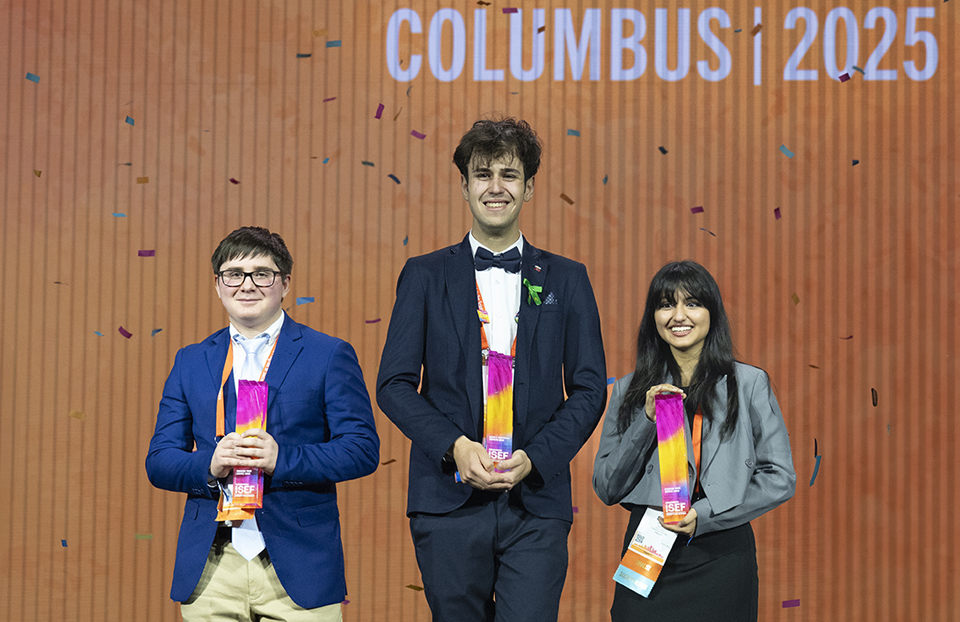Teen scientists and engineers win $5 Million at largest global high school STEM competition

$75,000 Top Award Goes to 16-year-old Michelle Hua for Novel Human Action Recognition Algorithm in Regeneron International Science and Engineering Fair 2021
Regeneron Pharmaceuticals, Inc. (NASDAQ: REGN) and Society for Science (the Society) announced that Michelle Hua, 16, of Troy, Michigan, won the $75,000 top award in the 2021 Regeneron International Science and Engineering Fair (Regeneron ISEF), the world’s largest global high school competition. Historically held in person, 2021 marks the first time in its more than 70-year history that the competition took place virtually.
The top finalists were honored during two virtual award ceremonies, the first of which aired on the evening of May 20 and featured Special Award winners. The Grand Awards Ceremony was held on the morning of May 21 and featured the announcement of the top prize of $75,000. In total, more than U.S. $5 million was awarded to the finalists, who were evaluated based on their projects’ creativity, innovation and level of scientific inquiry. The competition featured over 1,800 young scientists representing 49 states and 64 countries across the world.
Michelle Hua won first place and received the $75,000 George D. Yancopoulos Innovator Award, named in honor of the pioneering drug discoverer and Regeneron co-founder, President and Chief Scientific Officer, for her discovery of an artificial intelligence-based algorithm used for human action recognition. Using human silhouettes, she designed and implemented a novel deep learning framework that outperforms all similar state-of-the-art algorithms.
Catherine Kim, 18, of Jericho, New York, received one of two Regeneron Young Scientist Award of $50,000 for creating a novel hierarchical machine learning model that is able to predict adverse drug reactions with 91% accuracy, along with their underlying biological mechanisms.
Daniel Shen, 17, of Cary, North Carolina,also received the Regeneron Young Scientist Award of $50,000 for his development of an AI-powered facial-cue control module. Its high speed accelerates scientific discoveries, medicine research, and many other fields driven by large amounts of temporal data. The new algorithm has been adopted by researchers in Sepsis Shock diagnosis and Hurricane predictions.
“Congratulations to the Regeneron International Science and Engineering Fair 2021 winners,” said Maya Ajmera, President and CEO of Society for Science and Publisher of Science News. “Every single Regeneron ISEF finalist has persevered in their pursuit of science in the face of the myriad challenges of the COVID-19 pandemic, and we could not be prouder to showcase their work on a global stage. We look forward to seeing the contributions these young leaders continue to make to their fields and the world.”
Regeneron ISEF provides a global stage for future leaders in STEM – bringing together the best and brightest young minds to present their original research ideas to leading scientists and peers. Founded by the belief that advances in science are key to solving global challenges, Regeneron ISEF works to support and invest in young scientists who are generating ideas and acting as catalysts for the change needed to improve the well-being of all people and the planet.
“The Regeneron ISEF finalists form the next generation of remarkable STEM talent and deserve special commendation for their ability to complete and showcase their research during an unprecedented pandemic,” said George D. Yancopoulos, M.D., Ph.D., co-founder, President and Chief Scientific Officer of Regeneron. “The COVID-19 crisis and amazing global response have demonstrated the critical role that science and technology play in keeping people safe and healthy around the world. Regeneron ISEF recognizes the young scientists who are well-equipped and unafraid to tackle the existential threats facing our society. To all the participants: we need you more than ever, and congratulations on your achievements.”
Other top honors from the competition include:
John Benedict Estrada, 16, of Fresno, California, received The Gordon E. Moore Award of $50,000 for Positive Outcomes for Future Generations for his discovery of a novel computer program to accurately predict drought stress in plants using images from a custom-built robotic camera that captures infrared (IR) and visible light reflected off the leaves.
Arya Tschand, 17, of Marlboro, New Jersey received the Craig R. Barrett Award for Innovation of $10,000 for his development of an artificial intelligence model that inter-communicates to collect and analyze environmental data to give each crop its unique ideal irrigation volume. With accessible, affordable, and efficient technology, Arya believes that developing nations can leverage this solution to save trillions of gallons of water yearly.
Neha Mani, 17, of Bronx, New York received the H. Robert Horvitz Prize for Fundamental Research of $10,000 for her quantitative research of microbiology, which uses a diagnostic method to distinguish bacterial motion to diagnose Inflammatory Bowel Disease (IBD) by mathematically separating swarming from swimming.
Franklin Wang, 17, of Palo Alto, California received the Peggy Scripps Award for Science Communication of $10,000 for his project engineering machine learning to analyze public telescope data. Through his research, he discovered six never-before-seen near-Earth asteroids. His approach can be applied to any observatory to substantially improve the detection of and search speed for fast moving asteroids (FMAs.)
For a full list of finalists who won awards, please visit HERE and HERE.


